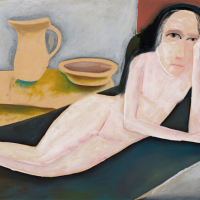37. CHARLES BLACKMAN

After leaving secondary school at thirteen, Charles Blackman worked in a series of transitory jobs in Sydney then Brisbane, without much success. It was not until after Blackman and his wife Barbara moved to Melbourne that he held his first art exhibition at his Hawthorn studio in February of 1952. The paintings depicted the uniformed schoolgirls he saw walking the surrounding suburban streets. This humble beginning immediately gave rise to major recognition of his now legendary Schoolgirls series, and by the end of the following year he had completed five further exhibitions in Melbourne, two in Sydney and one in Adelaide. Respected Melbourne critic, Alan McCulloch (1907-1992) predicted Blackmans success from the beginning, writing in response to his first exhibition, the curiously evocative quality of nearly all Blackmans painting could easily carry this artist on to a very special place in the Australian art of our time.1
After the success of his Schoolgirls exhibitions of 1952 and 1953, Blackman found himself abruptly propelled into the centre of the clash between traditional and modern art. Melbourne of the early 1950s still largely endorsed then Prime Minister Robert Menzies ambition to have a conservative Australian Academy of Art. Being ensnared in the wider public scrutiny of modern art so early in his career would have undoubtedly taken a toll. However instead of deterring him, it encouraged Blackman to further solidify his trademark style and just a few years later he created his iconic Alice in Wonderland series.
Early Morning Blues comes from this crucial period directly between Blackmans Schoolgirls paintings of 1951 to 1954, and his Alice in Wonderland series from 1956. The painting is typical of this transitionary period showing the artists continuing exploration. It bears stylistic similarities with the flatness and simplified forms found in the painting Running Man of 1956, held in the collection of the National Gallery of Victoria. The blanched, unsmiling face and the stencil-like shapes of the bowl and jug are repeated in his Self Portrait circa 1955 and The Blue Dress of 1954.2 Blackmans artistic style at this time was characterised by large flat planes, muted colours, and shadowless spaces in which he often used the corners of furniture to experiment with multiple perspectives. In Early Morning Blues these elements are effortlessly executed: the figure seems to float slightly above the dark surface below her; the two-toned background suggests the corner of a room, and the angles of the table are simultaneously at odds with each other and the surrounding space, hinting at multiple perspectives.
This rare and significant painting likely comes from the time Blackman spent at the poet Judith Wrights house in 1955 while she was away on holiday. Blackman recounted, after the Schoolgirl paintings, there were the paper paintings. The first batch of these I did were in the poet Judith Wrights house on Tamborine Mountain and I made a little studio in Judiths room where I painted two pictures a day for six weeks.3 As Blackman did not drive until he was forty, he recalls the difficulty involved in getting art supplies to the remote south-east Queensland town, explaining that, I had to carry everything myself, so I either painted on canvas or painted on paper and I couldnt afford to paint on canvas so I painted on paper.4 The present work fits directly midway in this important period in Blackmans career and represents the artist at his most characteristic.
Footnotes
1. McCulloch, A., Meanjin, May 1952, cited in Shapcott, T., The Art of Charles Blackman, Andre Deutsch, London, 1989, p.9
2. Shapcott, T., The Art of Charles Blackman, Andre Deutsch, London, 1989, illus. pl.37, 46
3. Blackman, C., cited in Shapcott, T., The Art of Charles Blackman, Andre Deutsch, London, 1989, p.18
4. Ibid.
Asta Cameron BA, MA (Art Curatorship)